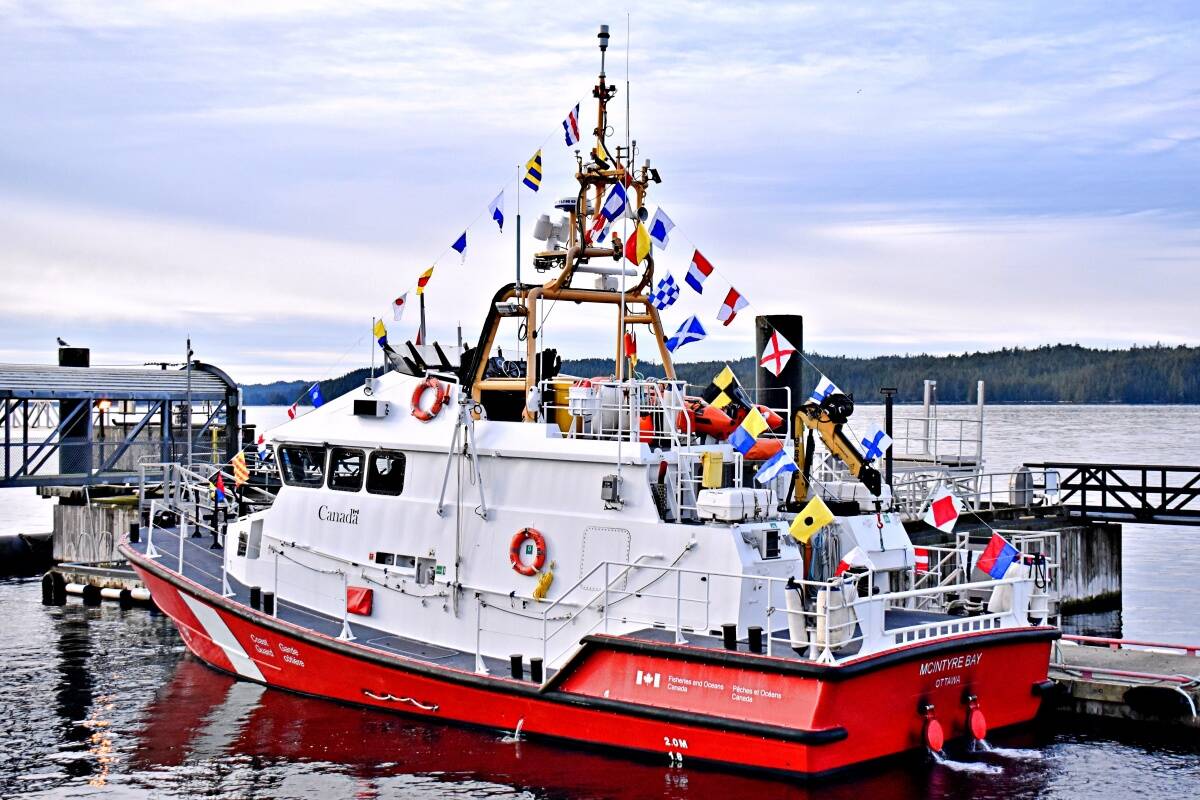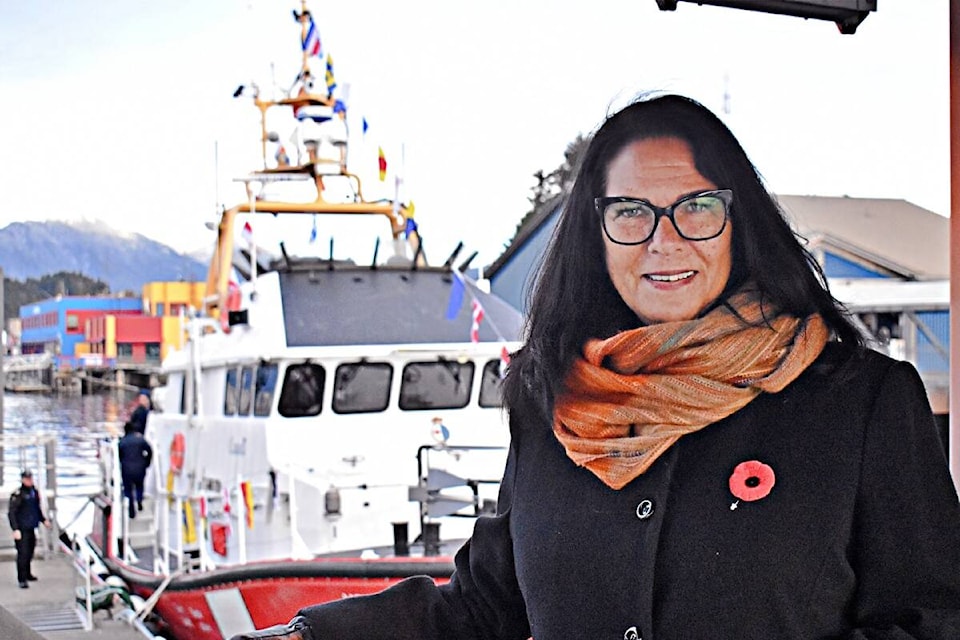A christening of champagne thrust across the bow of the Canadian Coast Guard Ship (CCGS) McIntyre Bay marked the vessel’s name and dedication into service in the Prince Rupert harbour on Nov. 9.
Derek Moss, Assistant Commissioner, Canadian Coast Guard Western Region joined Prince Rupert resident Lorie Palmer who is the vessel sponsor, in welcoming the 19-meter ship into the rescue fleet. The ship is one of 12 self-righting high-endurance search and rescue boats built under the National Shipbuilding Strategy.
Moss explained to the more than 50-member audience at the dedication ceremony, by tradition, a civilian is invited to sponsor a vessel for its well-being and continued service as well to wish the vessel “good luck”.
“The Canadian Coast Guard is proud to have Mrs. Lorie Palmer as the sponsor for the CCGS McIntyre Bay. In addition to being a long-time business owner and active member of the Prince Rupert community, Mrs. Palmer is deeply connected to the Canadian Coast Guard family,” a press release stated.
Born and raised in Prince Rupert Palmer served as home-front support to both her father and then her husband Les Palmer, who were both key members of the Canadian Coast Guard in Prince Rupert for many years, the organization said.
“The sponsor endows a ship with her identity and in doing so brings safeguards to all who sail on her. In this way, the role of the sponsor and the ship are connected. We invite the sponsor to have a long relationship with the vessel and the crews who will serve on her,” Mike Smith, CCG small vessel supervisor said, adding she will now become an honourary crew member of the vessel.
Smith praised the contributions of Palmer stating she is intimately familiar with the sacrifices and commitment of Coast Guard seagoing employees.
“It’s fitting that she is here today to dedicate and sponsor the commissioning of the Canadian Coast Guard ship McIntyre Bay … Her long-standing commitment and relationship with the Coast Guard continues as this vessel proudly serves mariners here in the Prince Rupert area.”
Palmer said she used to watch her father go to work every day from their house across from the Coast Guard base down in Seal Cove and then stood by her husband in his career on the water.
“I’ve been around them all my life. So, now I’m really connected,” she told The Northern View. “I”m absolutely very honoured to have been chosen to be a sponsor.”
“I spent a lot of my young life on the Coast Guard base. I knew the helicopters … I knew the Alexander MacKenzie when it would come in. So, it’s just part of my life,” she said, adding there are too many memories from a lifetime on the water to just chose one.
Palmer, the benefactor of the vessel, is now an honourary crew member of the 82 gross tonne McIntyre Bay with a cruising speed of 14.5 knots and a top speed of 25 knots.
The ship has been operating in British Columbia since 2019 out of its port home in Prince Rupert. It’s operational area includes Chatham Sound, Dixon Entrance and Northern Hecate Strait.
The ship is capable of travelling 250 nautical miles and is able to self-right if capsized.
These new lifeboats are specifically designed, equipped and crewed to respond to search and rescue and environmental response incidents, the CCG stated. The vessels will operate up to 100 nautical miles from shore, maintain a maximum 30-minute state-of-readiness and are typically ready to respond the moment an alert is received.
“The CCG plays an essential role in ensuring the safety of mariners and protection of Canada’s marine environment,” the marine first response organization stated. “This is why providing the Canadian Coast Guard members with the vessels they need to continue to deliver critical services to Canadians through the National Shipbuilding Strategy is a priority for the Government of Canada.”
To date, 11 other Bay Class search and rescue boats like the McIntyre Bay have been delivered and are stationed across Canada. As well, two channel survey and sounding vessels, seven hydrographic survey vessels and one coastal research vessel, making a total of 22 small vessels have been “built by Canadians for Canadians” under the program.
The new lifeboats are specifically designed, equipped and crewed to respond to search and rescue and environmental response incidents, the CCG stated. The vessels will operate up to 100 nautical miles from shore, maintain a maximum 30-minute state-of-readiness and are typically ready to respond the moment an alert is received.
The vessels and crews on them will provide key services including searches on the water, responding to marine distress response calls, environmental response operations as well as assistance to disabled vessels.
Canadians rely on the Canadian Coast Guard to keep waterways safe for mariners, protect the marine environment and respond to calls for assistance 365 days a year. On an average day, the Canadian Coast Guard coordinates the response to 19 search and rescue incidents, responds to 13 search and rescue incidents, assisting 43 people and saving 13 lives. This is why providing Canadian Coast Guard personnel with the vessels they need to continue to deliver these critical services to Canadians is a priority for the Government of Canada.
The new search and rescue lifeboats will contribute to Canada’s blue economy in keeping our waters safe for mariners and supporting environmental response operations to reduce the impacts of marine pollution in our waters.

